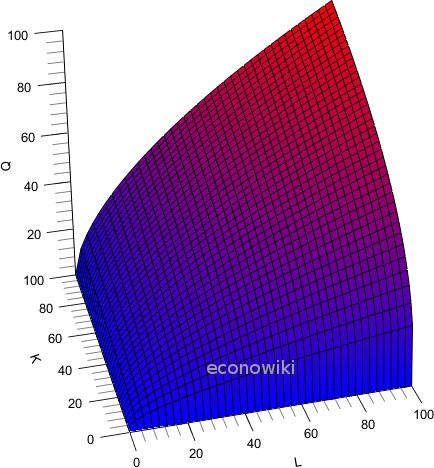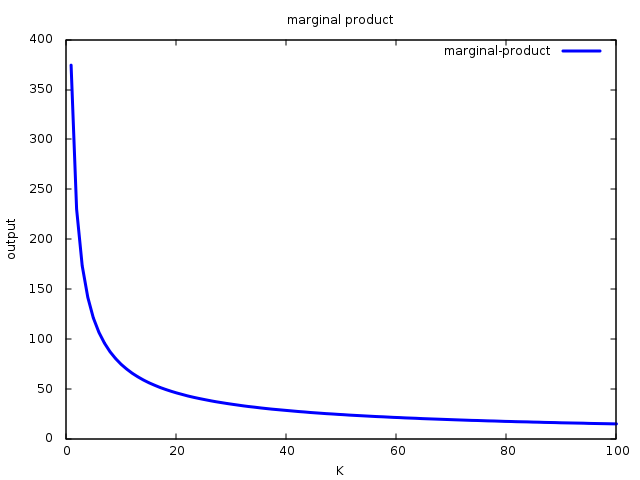This is an old revision of the document!
Table of Contents
Cobb-Douglas Production Function
The Cobb-Douglas Production Function is a particular form of the Production Function.
It takes the following form:
Q(L,K) = A LβKα
- L:labor
- K:capital
- Q:output
- A>0
- 0<α<1
- 0<β<1
The main characteristics of the Cobb-Douglas production function are:
- The marginal product is positive and decreasing.
- Output elasticity is constant, equal to α for L or β for K.
- Return to scale are constant and equal to α+β
Plot of a Cobb-Douglas production function:

The marginal product is positive and decreasing
This behavior is usually seen in a lot of real world examples. To find the marginal product of a production factor, we derivate the total output with respect that factor. For example, to find the marginal product of capital:
∂Q / ∂K =
= α * (A Lβ) K(α-1)
Given that α is positive and lower than 1, the marginal product is positive and decreasing.
Graphically:

Output elasticity is constant
Output elasticity is defined as the percent change in output, when there is a percent change in one production factor.
In the case of the Cobb-Douglas production function, output elasticity is constant. Output elasticity of labor is β and output elasticity of capital is α.
Proof
By definition, output elasticity is:
(∂Q/Q) / (∂L/L) =
= (∂Q/∂L) / (Q/L) That is the marginal product of labor divided the medium product of labor.
= [ Aβ Lβ-1) Kα ] / [ A Lβ Kα / L ]
Given that 1/L is L-1, ALβKα/L is ALβ-1Kα. It follows that output elasticity is:
= AβLβ-1Kα / ALβ-1Kα
The only difference between the numerator and the denominator is β; then:
Output elasticity = = AβLβ-1Kα / ALβ-1Kα = β
Discussion
If it is possible can someone post a real applicable example of how to calculate the elasticity of output with respect to labor and capital on Cobb Douglas function
Example function:
[1] Q=10 L^0.4 K^0.6Output elasticity (OE) with respect to K:
[2] (∂Q/∂K) / (Q/K)[3] (∂Q/∂K) = 10 L^0.4 0.6 K^-0.4[4] (Q/K) = 10 L^0.4 K^-0.4Then, the output elasticity is: [3]/[4] (notice that almost all components of [3] and [4] all the same, so they cancel each other.
[5] Output Elasticity = 0.6Complete case example should be better.